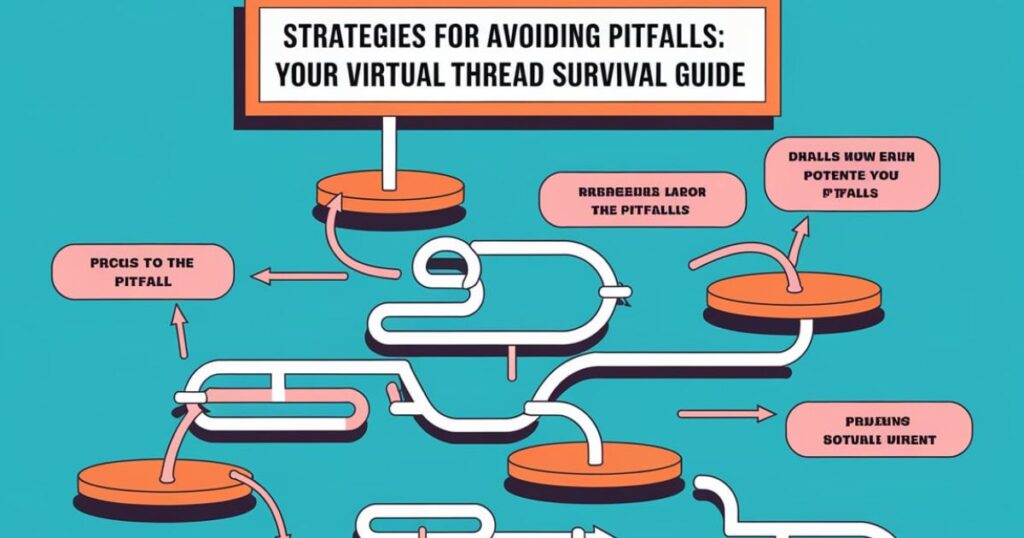In today’s fast-paced digital world, where multi-core processors reign supreme and users demand lightning-fast responses, mastering concurrency has become the holy grail of software development.
Enter virtual threads – a game-changing concept that’s revolutionizing how we approach concurrent programming. But like any powerful tool, it comes with its own set of challenges.
In this deep dive, we’ll explore the ins and outs of taming virtual threads, embracing concurrency, and steering clear of common pitfalls. Buckle up, fellow devs – it’s time to level up your concurrent coding game!
I. Introduction: Wrangling the Wild West of Virtual Threads
Picture this: you’re building an app that needs to juggle thousands of tasks simultaneously. Traditional threads start sweating at the mere thought, but virtual threads?
They’re like the cool kids at the concurrency party, ready to handle whatever you throw at them with style and efficiency.
As Brayan Bjorn, a renowned expert in concurrent programming, once said:
“Virtual threads are not just a new feature; they’re a paradigm shift in how we think about and implement concurrency in our applications.”
This shift is particularly crucial in our multi-core processor era, where harnessing parallelism can mean the difference between an app that sings and one that sputters.
II. Understanding Virtual Threads: More Than Just a Fancy Name
Let’s cut to the chase – what exactly are virtual threads, and why should you care? At their core, virtual threads are a lightweight concurrency abstraction managed by the Java Virtual Machine (JVM).
Unlike their beefy cousins, traditional threads, which map directly to operating system threads, virtual threads are nimble ninjas that can be created and managed by the thousands without breaking a sweat.
Here’s a quick comparison to illustrate the difference:
| Feature | Traditional Threads | Virtual Threads |
| Management | OS-level | JVM-level |
| Resource Usage | Heavy | Lightweight |
| Scalability | Limited by OS | Highly scalable |
| Creation Cost | High | Very low |
This lightweight nature is what makes virtual threads a game-changer for concurrent programming, especially when dealing with I/O-bound operations or scenarios involving significant wait times.
III. The Basics of Virtual Threads: Getting Your Feet Wet

Diving into virtual threads might seem daunting at first, but fear not! The beauty of this concept lies in its simplicity.
At its core, a virtual thread is just a task that can be executed concurrently with other tasks, without the overhead of a full OS thread.
Here’s a simple example to get you started:
Thread.startVirtualThread(() -> {System.out.println(“Hello from a virtual thread!”);});
This snippet creates and starts a virtual thread that prints a message. Simple, right? But don’t let the simplicity fool you – this little piece of code is leveraging some serious JVM magic under the hood.
IV. Benefits of Virtual Threads: Why Developers Are Jumping on Board
The advantages of embracing virtual threads are numerous and significant. Let’s break down the key benefits:
- Scalability on Steroids: Virtual threads allow you to create thousands, even millions of concurrent tasks without breaking a sweat. This is a game-changer for applications that need to handle a massive number of concurrent operations.
- Resource Efficiency: By decoupling the execution model from OS threads, virtual threads significantly reduce the resource overhead associated with concurrency. Your CPU will thank you!
- Simplified Mental Model: Writing concurrent code becomes more intuitive. You can focus on the logic of your tasks rather than getting bogged down in complex thread management.
- Improved Performance for I/O-bound Operations: Virtual threads shine brightest when dealing with I/O-bound tasks, making them ideal for network-heavy applications.
As we embrace these benefits, it’s crucial to remember that virtual threads are not a silver bullet. They’re a powerful tool in our concurrent programming toolkit, but like any tool, they need to be used wisely.
Read this Post: Optimum Energy Partners Lawsuit
V. Embracing Concurrency with Virtual Threads: Let the Good Times Roll

Now that we’ve covered the basics, let’s dive into how virtual threads are changing the game when it comes to embracing concurrency.
Efficient Task Management: Juggling Tasks Like a Pro
Virtual threads excel at handling I/O-bound operations. Imagine you’re building a web scraper that needs to fetch data from thousands of URLs.
With traditional threads, you’d quickly hit a wall in terms of scalability. But with virtual threads? It’s a whole new ballgame.
Here’s a simplified example:
List<String> urls = // … list of URLs to scrape
urls.parallelStream().forEach(url -> {
Thread.startVirtualThread(() -> {
// Fetch and process data from url
String data = fetchData(url);
processData(data);});
This code snippet demonstrates how easy it is to spin up virtual threads for each URL, allowing for efficient concurrent processing without the overhead of managing a thread pool.
Simplified Programming Model: Coding Made Easy(er)
One of the most significant advantages of virtual threads is how they simplify the mental model for concurrent programming.
You can write code using familiar thread-based constructs, but without worrying about the complexities of thread management.
For instance, consider this scenario where we need to process multiple files concurrently:
List<Path> files = // … list of files to process
ExecutorService executor = Executors.newVirtualThreadPerTaskExecutor();
files.forEach(file -> {
executor.submit(() -> {
processFile(file);});
This code creates a virtual thread for each file processing task, automatically managed by the JVM. No need to worry about thread pool sizes or thread lifecycles – it’s all handled for you.
VI. Common Pitfalls in Virtual Thread Usage: Don’t Let These Trip You Up
While virtual threads offer tremendous benefits, they’re not without their challenges. Let’s explore some common pitfalls and how to avoid them:
Overusing Virtual Threads: Too Much of a Good Thing
It’s tempting to create virtual threads with abandon, given their lightweight nature. However, creating an excessive number of virtual threads can lead to diminishing returns and even performance degradation.
Best Practice: Analyze your workload and find the optimal number of concurrent tasks for your specific use case. More isn’t always better!
Debugging and Monitoring Challenges: Where’d That Thread Go?
Virtual threads can be trickier to debug and monitor compared to traditional threads. Standard debugging tools might not provide the visibility you’re used to.
Solution: Familiarize yourself with specialized tools like Java Flight Recorder and VisualVM. These tools are designed to provide insights into virtual thread behavior and performance.
Resource Management: Avoiding the Resource Hunger Games
While virtual threads are lightweight, they still consume resources. Improper resource management can lead to issues like memory leaks or excessive CPU usage.
Key Tip: Implement proper resource allocation and release practices. Regular code reviews focused on resource management can catch potential issues before they become problems.
VII. Strategies for Avoiding Pitfalls: Your Virtual Thread Survival Guide

Now that we’ve identified the potential pitfalls, let’s arm ourselves with strategies to avoid them:
Balancing Concurrency Levels: Finding Your App’s Goldilocks Zone
- Analyze Your Workload: Understand the nature of your tasks. Are they CPU-bound or I/O-bound? This will help determine the optimal concurrency level.
- Benchmark and Profile: Use tools like JMH (Java Microbenchmark Harness) to measure the performance of different concurrency levels.
- Implement Adaptive Concurrency: Consider implementing a system that dynamically adjusts the number of concurrent tasks based on system load and performance metrics.
Using Profiling Tools: X-ray Vision for Your Threads
- Java Flight Recorder (JFR): This low-overhead profiling tool can provide detailed insights into virtual thread behavior.
- VisualVM: Offers a visual interface for monitoring and profiling Java applications, including those using virtual threads.
Implementing Proper Resource Management: Keep Your House in Order
- Use Try-With-Resources: Ensure resources are properly closed, even in the face of exceptions.
- Implement Timeouts: Prevent runaway threads by implementing appropriate timeouts.
- Regular Code Reviews: Schedule regular reviews focused specifically on resource management and concurrency patterns.
VIII. Conclusion: Taming Virtual Threads for a Concurrent Future
As we wrap up our journey through the world of virtual threads, it’s clear that they represent a significant leap forward in concurrent programming. By embracing virtual threads and avoiding common pitfalls, developers can create more efficient, scalable, and maintainable applications.
Remember, taming virtual threads is as much an art as it is a science. It requires a deep understanding of concurrency principles, careful consideration of your specific use cases, and a willingness to continuously learn and adapt.
So, fellow developers, are you ready to embrace the power of virtual threads and take your concurrent programming skills to the next level? The future of high-performance, scalable applications awaits!
IX. Additional Resources: Keep Learning and Taming Those Threads
To continue your journey in mastering virtual threads and concurrency, check out these valuable resources:
- Official Java Documentation on Virtual Threads
- Java Concurrency in Practice – A must-read book for any serious Java developer
- Project Loom: Fibers and Continuations for the Java Virtual Machine
Remember, the world of concurrent programming is constantly evolving. Stay curious, keep experimenting, and happy coding!

Hello, I’m Henry, a committed writer at supersbusiness.com, where I specialize in Business, Finance, Real Estate, and News. My articles explore a wide range of topics, providing readers with insightful and engaging content. With a knack for simplifying complex ideas, I aim to make my writing accessible and informative for all. Stay informed on the latest trends and insights by following me on supersbusiness.com.

